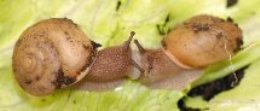
Reproduction
Although there no known reproduction studies specifically on
Stenotrema barbatum, reproduction processes can be
inferred from such studies as
"The Sexology of Polygyra
septemvolva Say, Life-History Notes, Possible Utility, and Data
on Stenotrema (Mollusca, Gastropoda, Pulmonata, Polygyridae)"
done by Glenn R. Webb. The species studied included those of the genus Stenotrema.
Observations showed that the process of mating was done in a
head to head position. The snails
lacked functional female organs, therefore mating only involved the
penes from each snail.

During mating, the genital pores dilated and the penes emerged, appearing as pale white, watery lobe-shaped appendages. After emergence, the penes from both snails intertwined clockwise. After about 3 to 12 minutes, each snail ejaculated semen, from their ejaculatory pore, onto their mate's penis near the pouch area.
However, cross fertilization did not occur each time mating was attempted. It was observed that during mating, each snail would gnaw on the other's penis. In some cases, the gnawing would cause one mate to retract its penis, which resulted in self fertilization.
Although mating was observed to be the same in all the genera, the genus Stenotrema was observed to have unique parts to their penes. Stenotrema stenotrenum, the closest relative of Stenotrema barbatum, had a short, conspicuous epiphallus inserting on the penis tip that bears a minute enveloped flagellum. The function of this structure is not concretely known at this time (Webb, 1950). For more information on the anatomical parts of the sex organs and reproduction of Stenotrema stenotrenum and other species of the genus Stenotrema click here.
To find out what happens after fertilization click here.
To go back to the home page click here.